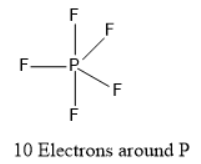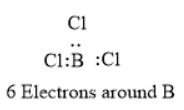
What are exceptions to octet rule?
A.The incomplete octet of the central atom.
B.An odd no. of electrons on central atoms.
C.Expanded octet of central atom.
D.All of these.
Answer
571.8k+ views
Hint:According to octet rule, the atoms tend to form compounds in ways that give them eight valence electrons and hence, they should obey electronic configuration of noble gas.
Complete step by step answer:
General exception of octet rule includes that the molecules that have an odd number of electrons on the central atom or the molecules which have more or fewer electrons than eight in its valence shell.
Compounds which have more than an octet of electrons are known to be expanded- valence molecules.
If we see in s and p blocks, there are very less number of molecules which have odd no. of electrons but in d and f block elements it is more common.
There are examples of molecules having odd numbers of electrons like \[NO\], Molecules that contain d block elements mostly contain odd numbers of electrons and hence their bonding cannot be explained by the simple approach.
There are only a few elements present in the p block that contain an odd number of electrons.
There are examples of some molecules which have more electrons than eight in its valence shell like $S{F_6}$ , if we see the Lewis structure of $S{F_6}$ it must accommodate a total of 48 valence electrons.
Molecules with atoms that possess less than an octet of electrons generally contain the lighter s and p block elements like beryllium which have four electrons around the central atom and also, boron which have six. Example of this is $BC{l_3}$, In this case a boron atom has six valence electrons while chlorine has eight.



Therefore, Option D All of these exceptions is correct.
Note:
According to the octet rule, the central atom must contain eight electrons but in some compounds there are fewer or more than the eight electrons and also, an odd number of electrons present in the central atom.
Complete step by step answer:
General exception of octet rule includes that the molecules that have an odd number of electrons on the central atom or the molecules which have more or fewer electrons than eight in its valence shell.
Compounds which have more than an octet of electrons are known to be expanded- valence molecules.
If we see in s and p blocks, there are very less number of molecules which have odd no. of electrons but in d and f block elements it is more common.
There are examples of molecules having odd numbers of electrons like \[NO\], Molecules that contain d block elements mostly contain odd numbers of electrons and hence their bonding cannot be explained by the simple approach.
There are only a few elements present in the p block that contain an odd number of electrons.
There are examples of some molecules which have more electrons than eight in its valence shell like $S{F_6}$ , if we see the Lewis structure of $S{F_6}$ it must accommodate a total of 48 valence electrons.
Molecules with atoms that possess less than an octet of electrons generally contain the lighter s and p block elements like beryllium which have four electrons around the central atom and also, boron which have six. Example of this is $BC{l_3}$, In this case a boron atom has six valence electrons while chlorine has eight.



Therefore, Option D All of these exceptions is correct.
Note:
According to the octet rule, the central atom must contain eight electrons but in some compounds there are fewer or more than the eight electrons and also, an odd number of electrons present in the central atom.
Recently Updated Pages
A man running at a speed 5 ms is viewed in the side class 12 physics CBSE

The number of solutions in x in 02pi for which sqrt class 12 maths CBSE

State and explain Hardy Weinbergs Principle class 12 biology CBSE

Write any two methods of preparation of phenol Give class 12 chemistry CBSE

Which of the following statements is wrong a Amnion class 12 biology CBSE

Differentiate between action potential and resting class 12 biology CBSE

Trending doubts
What are the major means of transport Explain each class 12 social science CBSE

Differentiate between homogeneous and heterogeneous class 12 chemistry CBSE

What is virtual and erect image ?

What is the Full Form of PVC, PET, HDPE, LDPE, PP and PS ?

The first microscope was invented by A Leeuwenhoek class 12 biology CBSE

Write any three uses of polaroids class 12 physics CBSE




